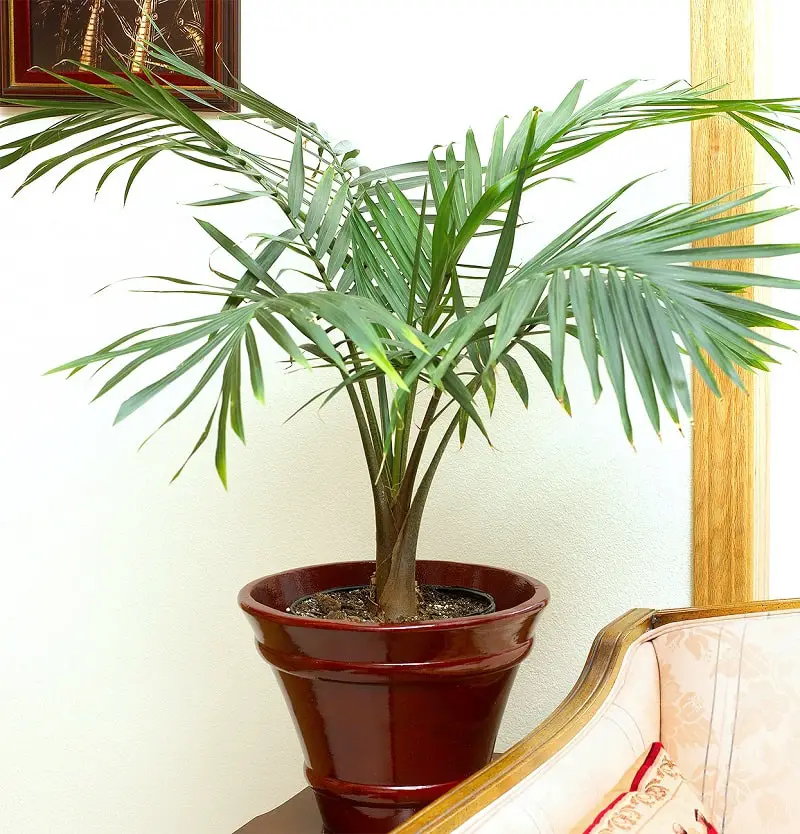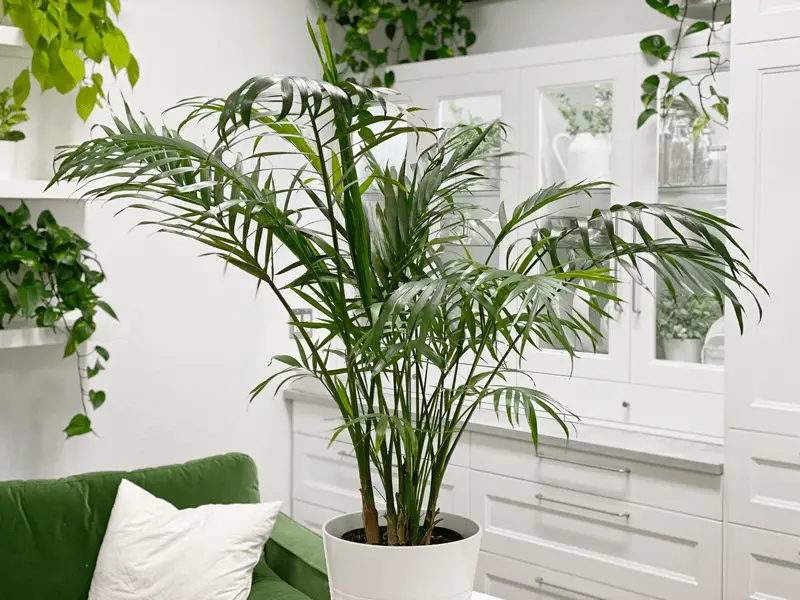Parlor palm (Chamaedorea elegans) is one of my favorite indoor palms. Thanks to the attractive bamboo-like stems and the ease to maintain. An individual needs to learn how to make parlor palms grow faster.
Parlor palm care tips involve the provision of bright indirect sunlight, well-draining soil, moderate soil moisture, average humidity, and a temperature range of 65-80oF. Feed the parlor palm once or twice during spring and summer with dilute liquid fertilizer.
The information in this guide sheet will help you have a thorough understanding of parlor palm care tips. Besides that, you’ll learn how to fix various parlor palm problems without seeking assistance from season growers.
You May Also Like: How to Grow and Care for Areca Palm

What Does Parlor Palm Looks Like?
Parlor palm is a lovely indoor palm with deep green foliages. The indoor palm grows in attractive clumps with light-textured foliages cloaking thin trunks.
The palm develops bamboo-like ridges along the trunk as it ages. A mature indoor parlor palm can reach four feet high under appropriate growing conditions.
Parlor palms also produce a cluster of yellow flowers that later develop into blackberries during the springtime. Indoor parlor palms do not bloom.
Chamaedorea Elegans experience a slow growth rate and can tolerate outdoor weather. Do not expose your palm to frost or freezing temperatures.
The palm fronds are suitable for flower arrangements, wreaths, and Palm Sunday decorations. It hails from Southern Mexico and the Guatemala rainforest.
Parlor palms are non-toxic to cats, dogs, and toddlers. I recommend keeping the indoor palm trees away from kids and pets to avoid destruction.
Parlor Palm Care Details
| Origin | Southern Mexico and Guatemala Rainforest |
| Botanical Name | Chamaedorea elegans |
| Common Names | Parlor palm Neanthe bella palm |
| Maximum Growth (Approx.) | 2-6ft tall and 2-3ft wide |
| Light Requirement | Bright indirect sunlight. Can also tolerate low-light conditions. |
| Soil Conditions | Fertile and well-draining soil. Mix equal parts of peat, compost, perlite, and potting soil. |
| Temperature range | 65-80oF (18-26oC) |
| Humidity Needs | Above 40%. The palm does best in high humidity environment. |
| Fertilizer Application | Once or twice during the growing season. Use a dilute liquid fertilizer. |
| Pruning and Maintenance | Low pruning requirements. Snip the dead or damaged fronds. |
| Propagation | Through seeds. |
| Bloom | A cluster of yellow flowers during springtime. |
| Re-potting | No need for transplant due to the slow-growth rate. |
| Pests and Diseases | Pests: Spider mites and mealybugs Disease: Root rot due to overwatering. |
| Toxicity | Non-toxic to cats, dogs, and humans. |
How to Care for Parlor Palm
Parlor Palm Soil Requirements
A parlor palm thrives in a rich potting soil that drains well. Heavy and compact soil retains much water that can cause root rot problems.
I recommend the use of peat-based mix rather than potting soil alone. The potting medium has ingredients that foster better drainage and fertility.
The slow-release incorporated in the pre-mixed potting medium fosters vegetative and faster growth among indoor palms. It also reduces the need for feeding your palm with liquid fertilizer.
Create a potting mix for parlor palms by combing equal parts of potting soil, peat, compost, and perlite. The potting mix is lightweight to facilitate better drainage and hold moderate moisture.
Does Parlor Palm Need Sunlight?
Indoor parlor palm loves bright indirect sunlight to thrive. But the palm can also tolerate low light conditions and artificial lighting.
Direct sunlight exposure might scorch the leaves. The indoor palm can withstand the early morning or late evening direct sunlight.
Place the parlor palm near the window that receives bright sunlight. Ensure the window has curtains or shears to reduce the sunlight intensity.
How Often Do You Water Parlor Palm?
Parlor palms are forgiving tropical plants that can tolerate moderate drought conditions for an extended period. Too much water makes the soil soggy and promotes root rot problems.
Soak the potting soil once every week during spring and summer. Reduce the watering frequency in winter due to palm tree dormancy phase and slow-growth rate.
The golden rule is to inspect the soil moisture content before watering your parlor palm. Insert the index finger in 2-3 inches of topsoil and soak with water if it’s dry.
Indoor Parlor Palm Temperature Requirements
Parlor palms are native to a tropical rainforest with warm and humid conditions. Indoor parlor palms can thrive under a temperature range of 65-80oF (18-26oC).
Replicating the native growing condition at home will help to reduce common parlor palm problems. Use a digital thermometer to monitor the indoor temperature fluctuations.
Move the parlor palm away from cold and hot drafts. The draft can damage the fronds and ruin the plant’s general appearance.
Parlor Palm Humidity Requirements
Parlor palms hail from the tropical rainforest of Southern Mexico and Guatemala. The region experiences consistently high humidity throughout the year.
Provide high indoor humidity levels for parlor palms to look healthy and happy. Low humidity makes the palm develop brown tips on the fronds.
I recommend the use of an electric humidifier to boost air moisture around the palm. Avoid misting the fronds to reduce the risk of leaf-related problems.
Another excellent option is to relocate the palm tree to the bathroom due to high humidity. Be sure to provide ventilation and adequate light for better growth.
Parlor Palm Fertilizer Application
Parlor palm is a heavy feeder tropical plant and can exhaust the nutrients from the potting medium after six months.
Feeding the palm once or twice during the growing season is vital. The nutrients help to facilitate vegetative growth and fast-growth rate.
Use a slow-release or dilute liquid fertilizer to feed your palm. Don’t fertilize the parlor palm during fall and winter due to the dormancy.
Too much fertilizer might burn the parlor palm foliages. Be sure to flush the potting soil every three months to avoid salt accumulation.
Parlor Palm Pruning Requirements
Parlor palms have low pruning requirements when compared to other indoor palms. Old fronds from parlor palms turn brown and drop without assistance.
Another option is to snip the brown tips and damaged fronds. It helps to keep the palm tree attractive and clean. Remember to use a sterilized blade to remove the old or damaged fronds.
I recommend allowing the old fronds to die naturally instead of pruning. It helps to reduce the risk of spreading plant diseases with a blade.
Parlor Palm Potting Needs
Juvenile parlor palms can thrive in 2-4 inch pots with drainage holes at the bottom. Re-pot a mature parlor palm to a five-gallon container.
Parlor palms experience a slow growth rate and the chance of roots filing a pot after one year is minimal. I recommend repotting the parlor palm due to root rot problems.
Inspect the roots and cut off the affected parts with a sterilized blade. Transfer the palm to a new container with fresh potting soil.
Develop a watering schedule to reduce the risk of overwatering and under-watering. Remember to inspect the soil moisture content before watering the palm.
Parlor Palm Propagation
Propagate the parlor palms through growing seeds. Mature palms bloom in presence of adequate natural light. The flowers develop into blackberries after pollination.
Extract the seeds from the blackberries and plant them in moist potting soil. These seeds might take an extended period to germinate despite providing favorable conditions.
I recommend visiting online plant stores to check out parlor palm for sale. Ensure the plant store is reputable before spending your money. (Check the Best Deals on Amazon).
Parlor Palm Problems and Solutions
Pests
Parlor palms are less vulnerable to insect infestation. But high humidity and poor ventilation will increase the risk of pest infestation.
Spider mites and mealybugs are the main sap-sucking creatures that attack parlor palms. Use an insecticidal soap spray to eradicate the pests.
Diseases
Parlor palms are less susceptible to common plant diseases. Overwatering will result in root rot problems and even kill the entire palm.
Grow the palm tree in fertile and well-draining soil that never gets soggy. Ensure the pot has drainage holes at the bottom to get rid of excess water.
Trim the affected root sections and transplant the palm in fresh potting soil. Be sure to inspect the soil moisture content before watering your palm tree.
Frequently Asked Questions
Why Does My Parlor Palm Have Brown Leaf Tips?
Parlor palms with brown leaf tips are due to the low humidity level. Use a humidifier to boost the indoor humidity level and keep your palm tree healthy.
Why Does My Parlor Palm Have Yellow Leaves?
Overwatering and low light conditions are the leading cause of yellow leaves. Other possible causes are low temperature, nutritional deficiency, and transplant shock.
Are Parlor Palms Toxic to Pets and Humans?
No. Parlor palms are safe for cats, dogs, and humans. I recommend keeping your palm tree away from pets and children to avoid destruction.
Does a Parlor Palm Produce Seeds?
Yes. But it takes years for a mature parlor palm to produce blackberries. These seeds from the berries are ideal for propagating a new palm tree.
Does a Parlor Palm Bloom?
Yes. An outdoor parlor palm blooms during springtime. It produces a cluster of yellow flowers that are unimpressive. Indoor parlor palm does not bloom at all.
You May Also Enjoy: How to Grow and Care for Calathea Makoyana

Final Thoughts
A parlor palm brings a tropical vibe indoors. These tropical palms are easy to grow and maintain regardless of an individual experience.
How to care for a parlor palm: Grow in a rich and well-draining soil, water when the top 2-3 inches of soil get dry, provide high humidity, and feed the palm once or twice during spring.
I hope the information in this care sheet has solved all the mysteries behind growing parlor palm at home. Use the comment section to share your experience and questions with us.
